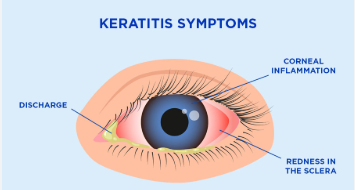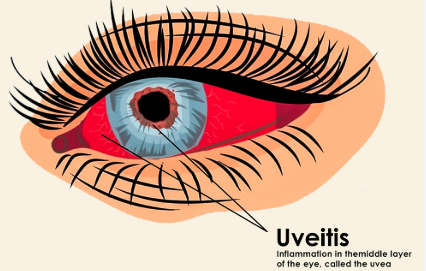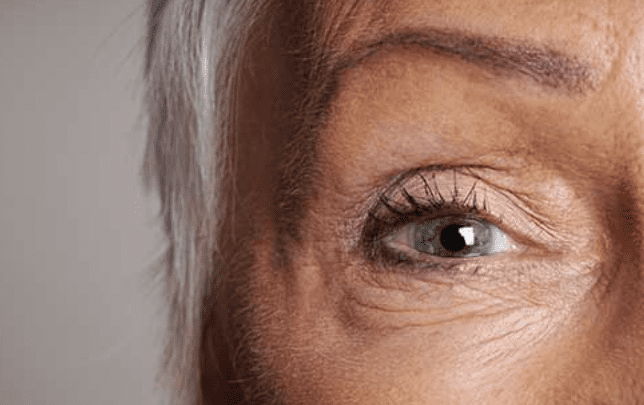Introduction
Fibromyalgia is a complex and chronic condition known for widespread pain, fatigue, cognitive dysfunction, and nervous system hypersensitivity. While its primary symptoms affect the musculoskeletal and nervous systems, many fibromyalgia patients also experience eye-related issues, such as dry eyes, light sensitivity, and blurred vision. One lesser-known yet serious eye condition that may affect fibromyalgia sufferers is keratitis (cornea inflammation).
Keratitis is an inflammation of the cornea, the transparent, protective outer layer of the eye. It can cause pain, redness, light sensitivity, vision disturbances, and, in severe cases, corneal damage or vision loss. Fibromyalgia may contribute to the development or worsening of keratitis due to immune dysfunction, chronic dryness, and nervous system hypersensitivity.
Understanding the link between fibromyalgia and keratitis symptoms can help in early detection, prevention, and management of eye health complications.
1. What is Keratitis?
Keratitis is the inflammation of the cornea, which may be caused by infections, dry eye syndrome, trauma, or autoimmune conditions.
Types of Keratitis
✔ Infectious Keratitis – Caused by bacteria, viruses, fungi, or parasites, leading to severe eye pain, discharge, and vision disturbances.
✔ Non-Infectious Keratitis – Triggered by dry eyes, trauma, allergies, contact lens overuse, or environmental irritants, leading to inflammation, redness, and blurred vision.
✔ Neurotrophic Keratitis – Caused by nerve dysfunction, reducing corneal sensation and making the eye more vulnerable to injuries and ulcers.
2. How is Keratitis Linked to Fibromyalgia?
While fibromyalgia is not a direct cause of keratitis, several factors associated with fibromyalgia may contribute to an increased risk of corneal inflammation.
2.1 Chronic Dry Eyes and Reduced Tear Production
✔ Many fibromyalgia patients suffer from chronic dry eye syndrome, which leads to irritation, corneal inflammation, and a higher risk of infections.
✔ Reduced tear production can cause the cornea to become vulnerable to damage and bacterial infections, increasing the risk of keratitis development.
2.2 Immune System Dysfunction
✔ Fibromyalgia is linked to immune system dysregulation, making individuals more susceptible to infections, including bacterial, viral, or fungal keratitis.
✔ Autoimmune conditions, such as Sjögren’s syndrome or lupus, which often overlap with fibromyalgia, can further increase the risk of corneal inflammation and damage.
2.3 Nervous System Hypersensitivity
✔ Fibromyalgia patients often experience heightened nerve sensitivity, which may lead to exaggerated pain and discomfort from even mild eye irritation.
✔ Neurotrophic keratitis (caused by nerve dysfunction) may develop in some fibromyalgia patients, leading to reduced corneal sensation, delayed healing, and increased risk of corneal ulcers.
2.4 Medication Side Effects
✔ Many fibromyalgia treatments, including antidepressants, muscle relaxants, and pain relievers, can contribute to dry eyes and corneal irritation.
✔ Long-term use of corticosteroids or immunosuppressants may increase the risk of corneal infections and keratitis.
3. Common Symptoms of Keratitis in Fibromyalgia
People with fibromyalgia may experience more intense and prolonged keratitis symptoms due to nervous system hypersensitivity and chronic inflammation.
Typical Symptoms of Keratitis Include:
✔ Eye redness and inflammation (increased blood vessel dilation in the cornea).
✔ Severe eye pain (may feel like burning, stinging, or sharp pain).
✔ Excessive tearing or watery discharge.
✔ Blurred vision or light sensitivity (difficulty seeing in bright environments).
✔ Swollen eyelids due to inflammation.
✔ Gritty or foreign body sensation (feeling like something is stuck in the eye).
✔ Clouding of the cornea (in advanced cases).
If left untreated, keratitis can lead to corneal ulcers, scarring, and permanent vision loss.
4. How Keratitis Affects People with Fibromyalgia
4.1 Increased Pain and Discomfort
✔ Fibromyalgia patients often have heightened pain sensitivity, meaning even mild eye irritation or dryness can feel extremely uncomfortable.
✔ Chronic nerve hypersensitivity may cause prolonged pain and difficulty in managing eye inflammation.
4.2 Worsening Fatigue and Cognitive Issues
✔ Eye strain and blurred vision can contribute to fibro fog (difficulty concentrating, mental fatigue, and confusion).
✔ Light sensitivity (photophobia) may cause additional headaches and discomfort, making daily activities more challenging.
4.3 Higher Risk of Eye Infections
✔ A weakened immune response can lead to frequent or recurrent corneal infections, requiring antibiotic or antiviral treatments.
✔ Delayed healing in fibromyalgia may result in prolonged recovery from eye infections or inflammation.
5. Managing and Treating Keratitis in Fibromyalgia
While keratitis can be serious, proper management can reduce symptoms and prevent complications.
5.1 Maintain Eye Hygiene and Reduce Infection Risk
✔ Wash hands frequently to prevent bacterial and viral infections.
✔ Avoid touching or rubbing the eyes, especially if experiencing irritation.
✔ Use clean contact lenses and avoid sleeping with them to prevent corneal infections.
5.2 Use Artificial Tears and Lubricating Eye Drops
✔ Preservative-free artificial tears help relieve dryness and irritation.
✔ Prescription anti-inflammatory or antibiotic eye drops may be needed for bacterial or viral keratitis.
✔ Avoid redness-reducing drops (such as Visine), as they can worsen long-term irritation and rebound redness.
5.3 Apply Warm or Cold Compresses
✔ Warm compresses can help relieve discomfort and improve circulation in the eye.
✔ Cold compresses can reduce swelling and pain.
5.4 Protect Eyes from Irritants and UV Light
✔ Wear UV-blocking sunglasses to reduce light sensitivity and corneal damage.
✔ Avoid smoke, dust, or allergens that may trigger eye inflammation.
✔ Use a humidifier to prevent dry eyes in air-conditioned or heated rooms.
5.5 Improve Nutrition and Hydration
✔ Drink plenty of water to maintain tear production.
✔ Eat foods rich in omega-3 fatty acids (salmon, flaxseeds, walnuts) to reduce eye inflammation.
✔ Increase vitamin A intake (carrots, spinach, sweet potatoes) for better corneal health.
5.6 Manage Fibromyalgia Holistically
✔ Improve sleep quality to support eye healing and immune function.
✔ Reduce stress and inflammation with yoga, meditation, or deep breathing exercises.
✔ Consider magnesium and vitamin D supplements, which can help reduce inflammation and nerve hypersensitivity.
6. When to See a Doctor
Seek medical attention if:
✔ Eye pain and redness persist for more than 48 hours.
✔ Vision becomes blurred or cloudy.
✔ Light sensitivity worsens significantly.
✔ Yellow or green discharge appears (indicating infection).
✔ A white spot on the cornea develops (a sign of corneal ulcer).
A doctor may recommend prescription eye drops, antiviral or antibacterial medications, or steroid treatments to manage keratitis effectively.
7. Conclusion: Protecting Eye Health in Fibromyalgia
Keratitis symptoms in fibromyalgia can be painful and disruptive, but early detection and proper eye care can help prevent complications and vision loss. By maintaining eye hygiene, using artificial tears, managing fibromyalgia symptoms, and seeking timely medical care, patients can reduce discomfort and protect their corneal health.
Would you like additional natural remedies or specific eye care recommendations for fibromyalgia-related eye issues?

Click Here to Visit the Store and find Much More….
For More Information Related to Fibromyalgia Visit below sites:
References:
Fibromyalgia Contact Us Directly
Click here to Contact us Directly on Inbox
Official Fibromyalgia Blogs
Click here to Get the latest Chronic illness Updates
Fibromyalgia Stores


